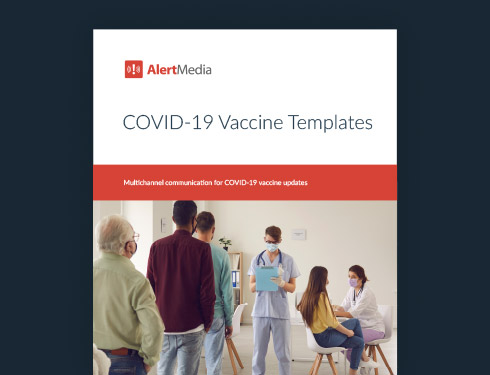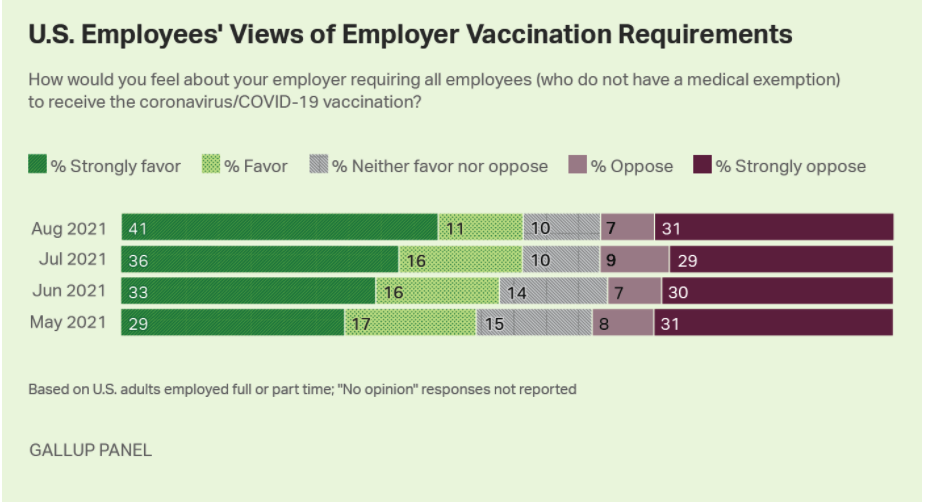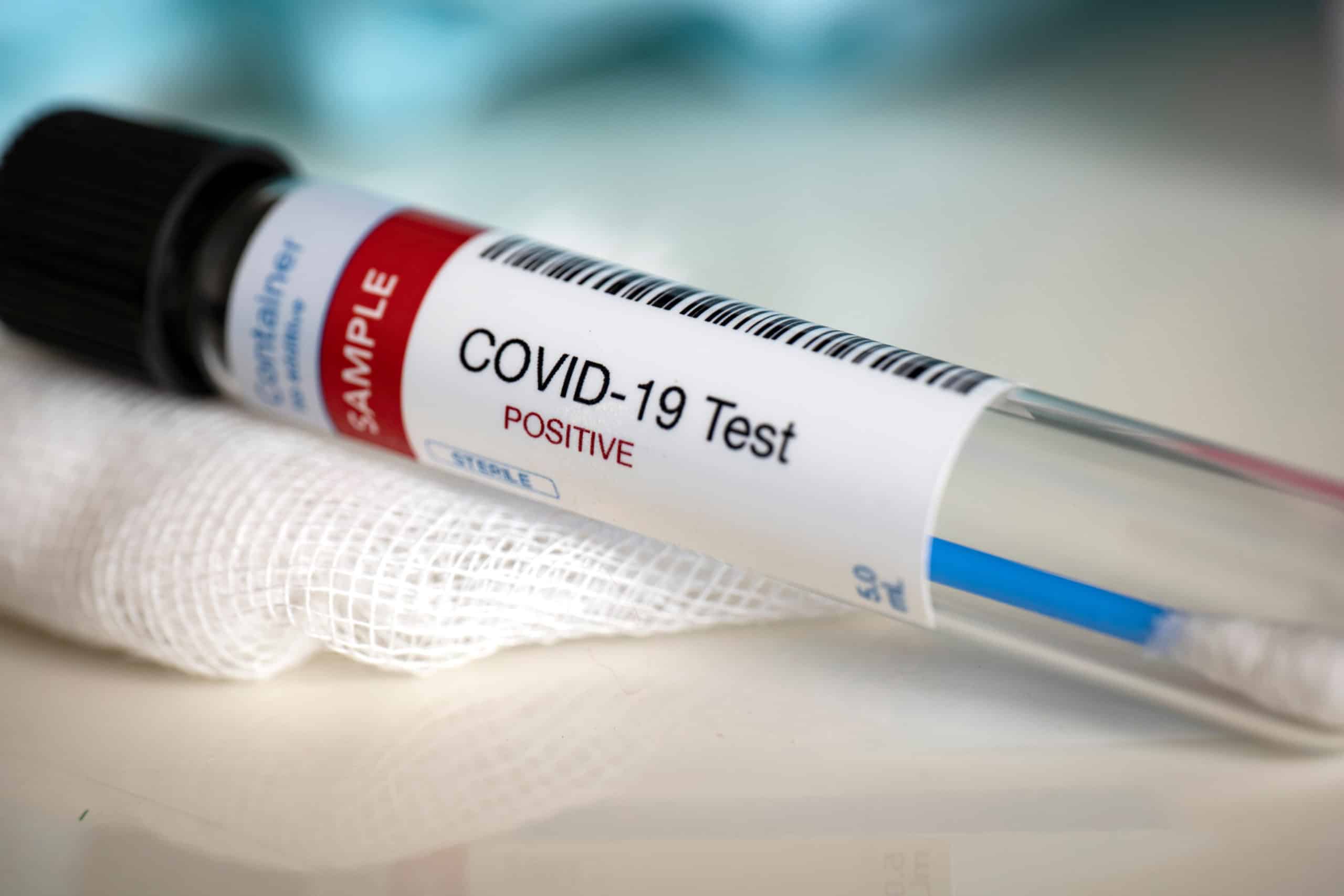
How To Create and Communicate a Workplace Vaccination Policy
In this blog post, we’ll explore key considerations for developing a COVID-19 workplace vaccination policy and messaging you can use to communicate decisions to employees.

It’s been 18 months since COVID-19 was declared a global pandemic by the World Health Organization (WHO). With more than 63 percent of people in the U.S. ages 12 and up now fully vaccinated and researchers increasingly confident vaccines for younger children will be available by the end of the year, many businesses are itching to return to normalcy.
For many, “normalcy” means getting employees back to working in-person in the office, at least part of the time. Employers are anxious to resume more normal business operations. The government is eager to re-establish economic stability and bolster consumer confidence. And millions of employees struggling with social isolation and work-from-home fatigue are ready for a change of scenery.
But there’s more to a COVID-19 return-to-work strategy than reconfiguring office space and writing up quarantine guidelines. As employers determine when and how to reopen their facilities, how your organization approaches employee vaccination will be an important consideration.
When developing a return-to-work strategy, you’ll need to consider COVID-19 vaccination questions like:
- What will your workplace vaccination policy be?
- Can (or should) you require employees to get vaccinated?
- How will you encourage employees to get the COVID-19 vaccine?
- Should you incentivize employees to get the vaccine?
- How will you communicate with employees about the COVID-19 vaccine?
In this blog post, we’ll explore important considerations for developing a COVID-19 workplace vaccination policy. You’ll discover several strategies other companies are using to encourage employees to get vaccinated, as well as how modern emergency communication technology can help your organization improve employee vaccination rates. Finally, we’ll cover messaging that you can use when discussing your COVID-19 vaccine policy within your company.
Download Our COVID-19 Vaccine Communication Templates
COVID-19 Vaccine Challenges in the Workplace
Navigating a return to work has not been easy for businesses. Between the slow initial rollout of the vaccine, rampant misinformation, and changing guidelines from officials, employers are constantly facing challenges in keeping their employees safe and their businesses up and running. And as organizations plan to bring more employees back to the physical workplaces, business leaders face another challenge: deciding whether or not to mandate vaccines.
Most employers have never had to decide whether to mandate a vaccine because of a public health threat, so deciding whether or not to require the COVID-19 vaccine in your business can be a daunting task. But following surging case volumes caused by the Delta variant, a recent survey shows that a growing number of companies—52 percent—are opting for some level of mandate.
Can employers require vaccinations?
In short, yes. The U.S. Equal Employment Opportunity Commission (EEOC) has stated that employers’ workplace vaccination policies can mandate employees receive an FDA-authorized or approved COVID-19 vaccine. There are, however, recognized protections that must be afforded to employees seeking exemption from vaccination requirements due to medical conditions or religious beliefs.
The EEOC also says that “employers should remember that guidance from public health authorities is likely to change as the COVID-19 pandemic evolves. Therefore, employers should continue to follow the most current information on maintaining workplace safety.”
The biggest challenge, however, is navigating this delicate issue with your employees. According to a recent Gallup poll, employees’ opinions on vaccine mandates are very torn, with most falling on the far ends of the spectrum: 72% are either very for or very against such a policy. However, based on the survey, more employees are falling on the “in favor” side, which is growing.
Tips for Creating a Workplace Vaccination Policy in Your Business
Whether you are just building out your COVID-19 vaccination policy or you are updating an existing policy, there are a few tips to take to build your policy.
1. Do your research
The COVID-19 pandemic is an ongoing and constantly changing situation, so make sure you’ve looked into the latest advice from experts. But you also need to know about any official requirements, especially as OSHA updates its policies in response to government requests. The last thing you want to do is roll out a policy only to revise it immediately, so take the time necessary to consult internal (and external) experts in advance to ensure your policy is clear and consistent.
2. Know industry trends
It can also be helpful to research what other businesses are doing, particularly businesses in a similar industry or a similar size as yours, so that you can provide a point of comparison when communicating with your employees.
3. Survey your employees
If you are unsure how your employees feel about a potential vaccine mandate, or if you want to know the vaccination status of your employees, send out a survey to hear from them directly. Getting an idea of how your teams will react can help guide your communication when you distribute your policy. However, keep in mind that you should be building a policy that is the best for your business, not just one that aligns with employee opinions.
4. Set processes ahead of time
If you do choose to mandate vaccines or even provide incentives, you’ll want to set your process early to ensure your human resources team is prepared. Decide if/how you will establish proof of vaccination and what will happen if employees do not follow your policy.
5. Coach your leaders
Your leadership teams and managers will be interacting directly with your employees, so it’s important to get everyone on the same page. At a minimum, make sure people leaders have been briefed on the policy in advance and know how to escalate questions they cannot answer themselves. Consider also providing leaders with pre-approved messaging and coaching on how to talk about the policy so that your employees are not getting mixed messages.
6. Communicate clearly
When it comes to implementing a workplace vaccine policy, remember that clear, consistent communication is vital. AlertMedia’s Chief People Officer, Laura Woolford, offers the following advice:
“When implementing new workplace policies like a vaccine mandate, it’s important to remember that keeping employees safe is not a political stance. Every employer has a responsibility to ensure their employees are safe and productive while at work. That doesn’t mean employees aren’t going to raise concerns, so leaders should be prepared to help them understand the ‘why’ behind the policy. Remind employees that you value their opinions while being clear about how decisions are reached.”
Coronavirus Vaccine Policy Communication Templates
Here are a few templates that you can use to make communicating your workplace vaccination policy easier. You can also find more COVID-19 vaccine communication templates here with messaging that can be tailored to your specific needs.
Short-Form Messaging (for text messages, push notifications, etc.):
At this time, [COMPANY NAME] [WILL/WILL NOT] require proof of vaccination to return to the office. This policy is effective [DATE]. Please refer to your email for more information.
Long-Form Messaging (for emails, Slack, Teams, etc.):
At this time, [COMPANY NAME] leadership has decided that we [WILL/WILL NOT] be requiring vaccinations to return to the office. This policy is effective [DATE], and you [WILL/WILL NOT] be required to [SHOW PROOF/AFFIRM] that you have received the vaccine.
You can expect regular updates from us about:
- Return to office plans and requirements
- Updates to workplace safety policies
- Vaccine-related PTO requests
Please reach out to your supervisor with any questions.
How to Encourage Employee Vaccinations
Whether you are mandating vaccines or not, there are several meaningful steps employers can (and should) take to encourage, incentivize, and facilitate employee vaccination.
Provide incentives
Some companies, especially those with a large frontline workforce, plan to pay their workers to get vaccinated. Dollar General, for example, offered employees $100 to get the COVID-19 vaccine. Southwest Airlines is also offering monetary incentives to employees who get vaccinated in addition to changing its policies on quarantine pay protections, limiting benefits to only vaccinated employees.
Providing a financial incentive for employees to get vaccinated—through a bonus, a cash stipend, hourly paid time, or even a gift card—has proven to be effective. Additionally, offering paid time off and shift schedule adjustments for employees to attend a vaccination appointment can help eliminate the financial stress of taking time off work to get the vaccine.
Make getting vaccinated convenient
Another way to improve employee vaccination rates is to make it as easy as possible for employees to get vaccinated. In years past, employers have encouraged workers to get flu vaccines by organizing on-site flu shot clinics—making it free, fast, and convenient to get vaccinated while at work. Earlier this year, Amazon—which has 800,000 workers in the U.S.—announced it had an agreement with a health care provider to vaccinate workers at its Amazon fulfillment centers, AWS data centers, and Whole Foods Market stores. And although it’s unlikely most companies will be able to offer on-site vaccines to employees for at least the next few months, every company can still make it easier for employees to get their shots.
Helping workers overcome common obstacles to getting vaccinated, such as lack of child care or transportation, can make it possible for employees to get the COVID-19 vaccine. Target, for example, covered the cost of a Lyft ride, up to $15 each way, for workers to get to vaccination appointments.
Educate employees on health benefits
Last but certainly not least, educating employees can help encourage those that might be on the fence to get vaccinated when they are eligible. As Walmart’s Executive Vice President of Health & Wellness, Dr. Cheryl Pegus has said of Walmart’s workplace vaccination policy, “We’re educating essential workers and all associates on getting the vaccine as soon as they are eligible. We are strongly encouraging all associates to get vaccinated but are not mandating anyone receive the vaccine, nor are we providing incentives at this time.”
To combat vaccine hesitancy, the Centers for Disease Control and Prevention (CDC) has several COVID-19 vaccination toolkits available to help employers build confidence in their workforce about getting the vaccine. In its toolkit for essential workers, for example, the CDC includes a variety of templates, printable posters, and vaccine fact sheets employers can use to educate employees, raise awareness about the benefits of vaccination, and address common questions and concerns.
Additionally, the U.S. Equal Opportunity Commission (EEOC) has published guidance for employers regarding the expectation for reasonable accommodations and non-discrimination as specified by the Americans with Disabilities Act (ADA).
Using Technology to Improve Vaccine Policy Communication
Using modern emergency communication software, organizations can easily and dramatically improve how they communicate with employees about the COVID-19 vaccine and their workplace vaccination policy. A system that offers multichannel, two-way messaging—along with global threat intelligence and survey functionality—can be an effective tool in encouraging employee vaccination and facilitating a safe return to work.
Emergency communication software with integrated global threat intelligence enables organizations to more effectively monitor and communicate about COVID-19 hotspots—and any resurgence of new strains—and stay on top of evolving CDC guidance. And a solution with survey functionality and other two-way communication features can help your organization solicit feedback from employees about their intent to get the vaccine, their desire to return to work, and their thoughts on the workplace vaccination policy you introduce. Using surveys, companies can also conduct employee health and symptom screenings to ensure the safety of unvaccinated employees returning to the office.
For example, California-based Paradise Valley Estates—a 76-acre nonprofit senior living community home to more than 500 residents—recently used AlertMedia’s emergency communication software to increase participation in its on-site COVID-19 vaccine clinic. Paradise Valley Estates used AlertMedia to communicate important information to residents about vaccine logistics and access. Residents were assigned specific appointment times based on their neighborhood, and AlertMedia was used to send messages to residents letting them know when they could arrive at the vaccination site.
In Conclusion
Navigating the challenges and pitfalls of the Coronavirus pandemic is a struggle that all businesses are going through right now. Building out and communicating your workplace vaccine policy is an important step to keeping your employees safe and informed, and your business running smoothly. And using a mass notification software solution will make it much more efficient to share educational resources about the COVID-19 vaccine, communicate your organization’s vaccine policy, and distribute public health information about vaccine availability. You can send critical notifications, like the templates included in this article, across multiple channels—including email, text message, phone call, and mobile app—every employee will receive targeted, timely, and accurate information.




![Navigating a Safe and Stable Return to the Workplace [Webinar Recap]](https://www.alertmedia.com/wp-content/uploads/2021/05/Blog-BackToWork-Webinar-v1.jpg)
